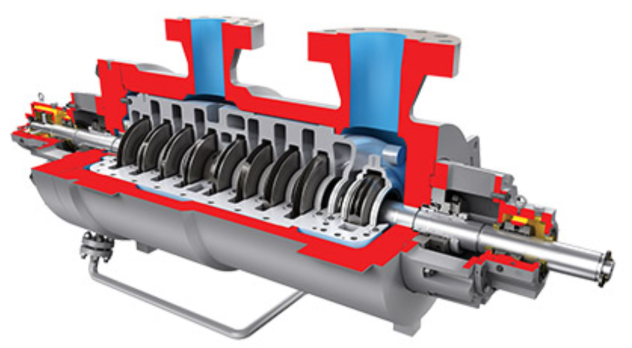Centrifugal pumps
Failure investigation, remedies, and mitigation of a centrifugal pump.
A high energy pump at a water injection station in El Furrial, Venezuela exhibited extremely high vibration levels prior to an overhaul. It then suffered a catastrophic failure during startup following overhaul. The hydrodynamic bundle, rotor, and drive end (DE) bearing suffered damage.
High energy pump for boiler feed water. Courtesy of Flowserve.

This centrifugal pump is a 3,000 HP, double-case volute, boiler feed water pump type. It has nine stages, outputs 750 gpm of water with suction pressure 1800 psi and discharge pressure 5250 psi. Rated speed was increased from 6000 to 6600 RPM to enhance the hydraulic performance. However, the pump’s actual discharge pressure was about 4,500 psi, well below the target value of 5,000 psi. The coupling was reportedly poorly fitted.
The increased RPM created rotordynamic concerns of getting closer to a critical speed, thus the operator wanted to know about the synchronous regime. The operator also wanted remedial measures and temporary mitigation steps to keep the pump running for 4-6 months until remedies were finally enforced.
The course of action for this investigation was clear since the beginning: conduct an internal clearances analysis and a forced response rotordynamic study.
A thorough study of internal clearances was conducted. Table 1 shows the results from this study featuring a comparison between internal (hydrodynamic bundle) clearances from different data sources, namely: design data, shop measurements, API-610 minimum clearances, and typical clearances for a similar pump with vibratory problems. As a result, the recommended clearance for the center seal, balance piston, eye, and impeller hub seals are shown in the bottom part of Table 1.
Due to the high vibration levels (20 mil DE, 5 mil NDE) reported before the overhaul, a simulation of the pump’s forced response rotordynamic behavior was attempted using a trial unbalance weight located in the coupling. A mass-elastic mathematical model incorporating the effect of the internal seals at 1X and 2X design clearance (as suggested by API 610) was used for this purpose.
One can expect a flexible rotor behavior (first critical speed below operating speed) for this high-speed, long slender shaft, but the stiffening effect provided by the internal seals (Lomakin’s effect) locates the first critical speed in the vicinity of 9,000 RPM, well above 6,600 RPM operating speed. Retrofitting the bearing and coupling with the technology presented below raises this first critical speed to approximately 10,000 RPM, thus discarding the likelihood for resonance despite the steep vibration plot obtained during a ramp up vibration survey.
Table 1: Analysis of internal clearances.

REMEDIES AND MITIGATION
Our attention was focused on balancing and the effect on the dynamic stability of the rotor-bearing-support substructure. A bearing and coupling retrofit was recommended with a balancing plane on the coupling and an added mass on the bearing housing. It was discovered that the shaft was excessively long on the DE. Shortening the shaft together with a reduced moment coupling proved to be beneficial in keeping rotor synchronous response away from resonances. Such coupling design has a center of gravity and flex discs moved closer to the bearing.
tilting pad bearing is a good option for stability and support of this slender high-speed shaft. A pad load distribution analysis showed increased clearances unloading the top pads and the six-pad arrangement offered the best support. Furthermore, a lateral stability analysis revealed six-pad bearing to have the best stability parameters (whirl mode, log dec, amplification factor, undesirable speeds).
Effective mitigation measures that ran for a few months with acceptable vibration levels turned out to be:
- Add 150lb to the bearing housing.
- Increase internal clearances and bearing clearances (max 6 mil).
- Finning the bearing housing ribs for enhanced heat dissipation.
- Using the coupling as a balancing plane; adjusting and balancing the coupling.
- Correct bearing housing distortion.
CONCLUSIONS
The most likely cause of failure was attributable to tight clearances found in the hydrodynamic bundle’s internal seals. OEM design and even API clearances were considered to be too tight. Reducing internal clearances below API 610 recommendations exposes these pumps to catastrophic failures during start up. For the impeller eye, we recommend a 50% increase (to 27 mil) over API values for stages 1–4 and a 25% increase (to 23 mil) for stages 5–9. Clearances for other rotor locations are shown in Table 1.
Trimming the shaft in the DE side and installing a reduced moment coupling helps in separating the operating speed from the first critical envelope, thus reducing the amplitude of vibration.
